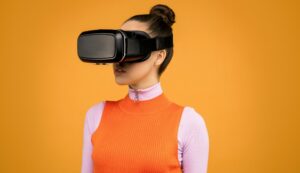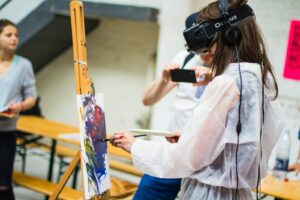VR as a New Experience
”Virtual reality (VR) creates a simulated environment through head-mounted displays (HMDs) and creates an immersive and interactive experience for the user”.
Jennifer Fromm
I believe much of this experience is based on the fascination of reaching and discovering new things in the very easiest setting. The affordances in VR seem limitless. The ease of setup and cross-platform usability is proof of a cutting edge and progressive technology. During the use, however, the smaller frailties become perceptible. VR goggles are new, especially to our eyes and psyche. Discussions with different people about VR always included the unsolved question: How healthy is VR? You can’t answer this question yourself, which is inevitable in the back of your mind every time you use the goggles. Furthermore, the infinite usability of the VR goggles diminishes at the latest when you are redirected to services such as PayPal after a short trial of the app. Of course, developers want to be rewarded for their work.
Can You Really Work with Colleagues in VR like in Real Life?
Collaboration in groups requires the highest level of communication and the associated non-verbal interactions. In the Corona era, many platforms such as Zoom aim to facilitate this, but is VR not actually more appropriate and better? Every WI student in M ̈unster is familiar with the situation from before: sitting at the whiteboard in the WI library and the markers were empty or even missing. In VR, these problems do not exist. Digitalisation ensures unlimited accessibility of post-its, pens, whiteboards, etc. The extensive revisability sets no limits to the creativity of the individual. In brainstorming, popular tools such as post-its can be used as in real life, in prototyping, 3D material can easily be loaded from the browser without the constraints of a limited LEGO palette in front of one’s eyes. As in Zoom, screens can be shared. And additionally, as in real life, valuable interaction is possible. Hands can be used to visualise, place stuff, remove and move stuff, write on the whiteboard, zoom in and out, but also point things – features that come dangerously close to real life and even without media breaks. But the range of options creates a perceived higher risk of distraction. Of course, this can also be due to the novelty and the resulting curiosity. Furthermore, higher barriers to entry arise for users. It takes a while until even the last person is familiar with VR. The explanation can create stress and already seem tiring at the beginning, which has consequences for the group dynamics.
Learning about Design Thinking Resulting From the VR Experience
The aforementioned group dynamics became more significant for me through VR. The barriers to entry created an inhibited situation, and productive work was consequently not as easy. Right at this point, the use of warm-ups proved to be very beneficial. Without actually considering the exact techniques, we managed quickly to use humour and communication to create a better atmosphere. Furthermore, it was obvious to anticipate the potential physical space requirements for Design Thinking, as even in some VR Environments space was getting too small. If coordination is lacking, design thinking can quickly end in chaos.
Can You Convince the Recruiter with VR?
Whether you can convince the HR manager with VR as a skill like Office, I doubt. But many companies have understood the emerging value through VR, such as PWC. If the acquired soft skills through VR are made apparent and can be assessed, VR can certainly be presented as a skill in the recruitment process. Furthermore, it depends on other factors such as whether VR is used as a hard skill in the company (e.g. pilot training) or whether VR is a future topic for the company.



